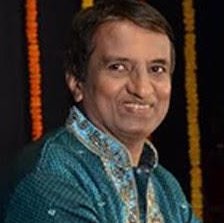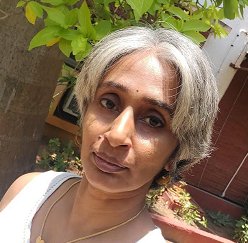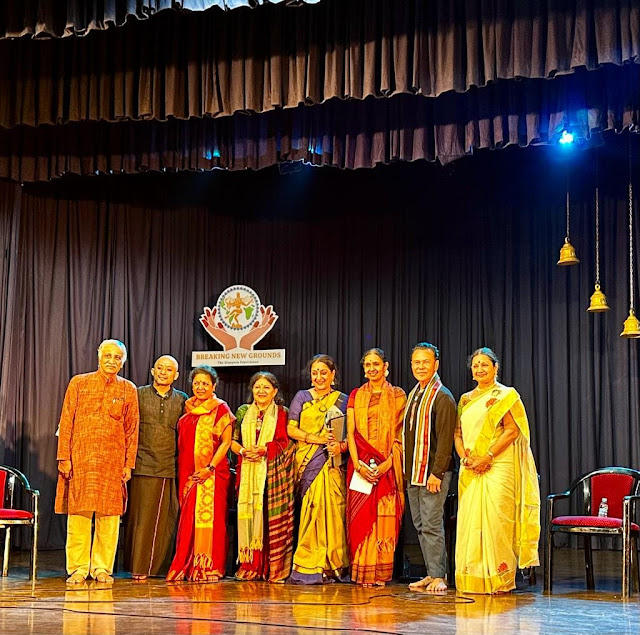Ramya Ramnarayan
Ramachandram Bhavayami Program and Dates
AUDIENCE REVIEW: An Enchanting Thematic Performance at Seva Sadan, Bengaluru, India
The performance "Lila" by Ramya Ramnarayan, the New York-based Bharatanatyam artist and her students, at Seva Sadan Bengaluru on January 6, 2024 was a devotional tribute to Krishna, following the Margam format. The story began with a Prabhandha Mala, a solo performance by Ramya Ramnarayan.
The artists performed the Mallari and the Raas Leela with virtuosity, demonstrating the harmonious blend of Nritta and Natya. The Mallari was a lively and rhythmic dance that set the stage for the Raas Leela, which was a dramatic and expressive depiction of the love between Krishna and the gopis. The dancers created a captivating spectacle of movement and emotion that enthralled the audience
The Swarajati in Husseini Raga, a composition of Melattur Venkatramana Sastri, portrays Nayika's anguish as she confronts her Lord Vishnu for his neglect of her. She reminds him of his various avatars to rescue many souls and wonders when he will show his love for his childhood companion. The sancharis illustrate Rukmini's liberation from Sisupala and the extraordinary Vatsalya Bhava by Krishna towards Kuchela, dramatised with eloquence and emotion. The rhythmic patterns highlighted by the signature vibrant nattuvangam by Kiran Subrahmanyam added flair to the presentation.
The artistic vision of Ramya Ramnarayan was brilliantly expressed by the dancers Ramya Ramnarayan, Sujatha Ramanathan, Rakshita Raghunathan, Ragini Iyer, Sai Sruti Sitharaman, Samyukha Neeraj and Shriya Arunkumar. They created a captivating spectacle of rhythm and movement that showcased their skill and grace. The different layers of expression were strengthened by emphasis and elaboration. The choreography was innovative and engaging, blending traditional and contemporary elements harmoniously.
The Devarnama "Krishna Nee Begane Baaro" is a lyrical composition that expresses the maternal love of Yashoda for her son Krishna, who is the incarnation of Lord Vishnu. In a solo performance, the dancer, Ramya Ramnarayan, poignantly portrayed the various aspects of Krishna's divinity, including showing the glorious universe in his mouth. The dancer captured the emotions of Yashoda, who longs for Krishna to return to her after his adventures, and who marvels at his divine attributes that reveal his true identity as the supreme lord.
The artists concluded their performance with a Thillanna that incorporated the elements of Kathak’s Tarana in Ahir Bhairavi, a piece composed by Balamuralikrishna. The performers displayed their skill and passion through their energetic movements. They also wore costumes that matched the theme and the aesthetics of their performance. The audience was captivated by their impeccable execution and their artistic expression of the music.
The artists were accompanied by a musical ensemble that created a harmonious and captivating soundscape. Rohit Bhat's vocals, Narsimhamurthy’s flute, Anoor Vinod Shyam's mridangam and Kiran Subrahmanyam's nattuvangam blended seamlessly and added depth and richness to the performance.
Author:
Satish Suri
Photo Credit:
Shandilya Srivatsa
Lila Review on Narthaki
Lila - Divinity with aesthetic quality
The Husseini Swarajathi, a composition of Melattur Venkatarama Sastri, in which the nayika as the protagonist has a dialogue with her lover Lord Vishnu and asks, "Why are you ignoring me? Has anyone poisoned your thoughts to which you are carried away?" In this item two stories are interpreted that reveals the grace and kindness of the Lord, the first one being how Krishna rescues Rukmini from Sisupala and the second the affection of the lord showed to his childhood friend Kuchela. The nayika wonders when the Lord will shower his benevolent glance on her. The artistes danced with fine coordination and uniformity, creating a fine spectacle.
The popular composition "Krishna nee begane baro" was performed by Ramya Ramnarayan that establishes the vatsalya bhava and the unique bonding of mother Yashoda with little Krishna, executed with commendable abhinaya that included the innocence and the charm of little Krishna.
The finale number was the complex Balamuralikrishna Thillana in Ahir Bhirav, the tremendous artistic ability of the dancers as they danced immaculately revealing their command over technique and the stylistic quality of the performance. Concept and choreography were by lead dancer Ramya Ramnarayan, ably supported by Sujatha Ramanathan, Rakshita Raghunathan, Ragini Iyer, Saisruti Sitaraman, Samyukta Neeraj and Shriya Arunkumar.
The musical credits goes to Hariprasad Kanniyal for vocal, Kaushik Champakesan for nattuvangam, Nagai Narayanan for mridangam, Kalaiarasan for violin and Muthu for flute. Other credits include Sandhya Raman for costumes and Murugan for lights. On the whole, 'Lila' was a fine combination of both divinity and aesthetic quality.

Vijay Shankar is a Kuchipudi and Kathakali exponent, teacher, bilingual journalist, arts critic and actor.
e-mail: vijaydance@gmail.com
Photos courtesy: Ramya Ramnarayan
January 29, 2024
Narthaki Review on Vatavriksham Performance!
The first item was a Prabandha mala, where Ramya strung together 4 pasurams of Thondaradipodi Azhwar, Periyazhwar and Andal with the music set by SK Rajaratnam Pillai. It commenced with the description of the majestic beauty of Ranganatha through the “Pachai ma malai pol meni.” The nritta flowed into Periazhwar’s “Pallandu Pallandu”and later into “Nayakanai nindru,” the 16th pasuram (chosen for that day of Margazhi). Through the course of these pasurams, the dancer elaborated their lyrical value and interspersed with short jathis. On stage, she was the earnest Azhwar having intimate, lyrical conversation with the lord. Her interest in the Divyaprabandham and other Vaishnava works added a spiritual richness to the Prabandha mala and moved the viewers. It ended with the “Chittranchiru kalai.”
“Ma mohalahiri meeruthey” in ragam Khamas was the varnam for the evening. The nayika is in love and searches for a messenger to let Muruga know about her state. She implores her sakhi who is disinterested and then her parrot who wouldn’t listen. Then she spots the peacock, the vahana of Muruga and wants him as the messenger. The first sanchari ended with her spotting the peacock and then flowed into the jathi depicting a beautiful peacock dance. The nayika fails to get the birds to do her bidding and again takes up her cause with the sakhi by extolling Muruga. He is the one who led the devas to vanquish Tarakasura, and on whom Shakthi bestowed the divine spear. He dwells in the Kazhugumalai, the road to his dwelling is full of beautiful carvings. The king himself treks up those hills for his darshan. ‘Give my message to him when he is alone, not when with Valli.’ The varnam progressed as a story, the nayika awaits the return of the sakhi, understands that she has been rebuffed and laments that relationships with men are fleeting. They go through stages; the agony of break-up always follows the ecstasy. She remains in love but reconciles herself and is wiser. Ramya leveraged the beautiful music and sahithyam to move the varnam forward as a single story, flowing from jathis to hands to sancharis seamlessly. The nayika traversed through a gamut of emotions, from excitement, irritation, hope and then abruptly into acceptance and fond remembrance, skipping the essential in-between disappointment.
This was followed by her experimental work ‘Surrender’ (a collaboration with Maya Kulkarni, music by Rajkumar Bharati), exploring Krishna through a Meera bhajan and a Nachiyar Thirumozhi pasuram. As Meera, Ramya danced to the verses from “Jo tum todo piya,” showing her mad love for Krishna and then as Andal to a Nachiyar Thirumozhi pasuram depicting her inner churn. She aspired to link the two verses through the metaphor of ocean. Both Krishna bhaktas offer contrasting images – the princess who considers herself to be a Krishna dasi and a mere fish in the ocean and Andal, assertive and demanding her place, saying, ‘like the ocean you churned, my mind is churned by longing.’ Sequencing the bhajan and pasuram back-to-back gave the impression of these being standalone dance sequences and did not fully present the possibilities suggested by the name. Bhakthi overrode the nuances the nayikas had to offer, nevertheless giving a spiritual joy to the viewers. Ramya concluded her evening’s dance performance with a Gambeeravani thillana.
The orchestra was rich with bhava and held its own even while being in sync with the performance. One could look at the orchestra and feel the dance. Swamimalai Suresh was on vocal and nattuvangam and evoked memories of SK Rajaratnam Pillai. Eshwar Ramakrishnan on violin, Nagai Narayanan on percussion and Muthu on flute completed the music ensemble. The venue was PS Senior Secondary School where the stage didn’t offer enough depth to the dance.
Vatavriksham held an old-world charm, where the performance weighed the poetry, music, nritta and nritya in the right proportions without some of the excesses seen onstage these days.

e-mail: sreelatha.rajan@gmail.com


.jpg)





.jpg)




























.jpeg)






.jpeg)





